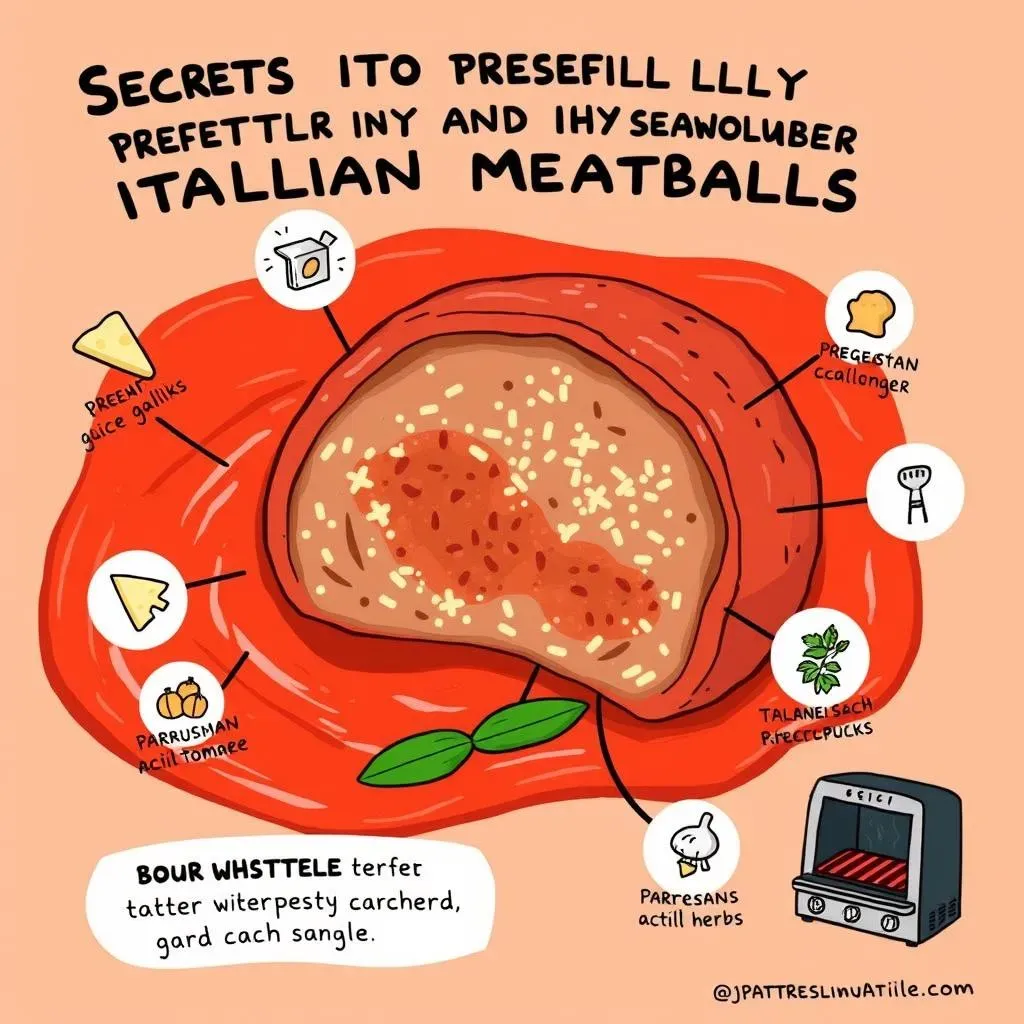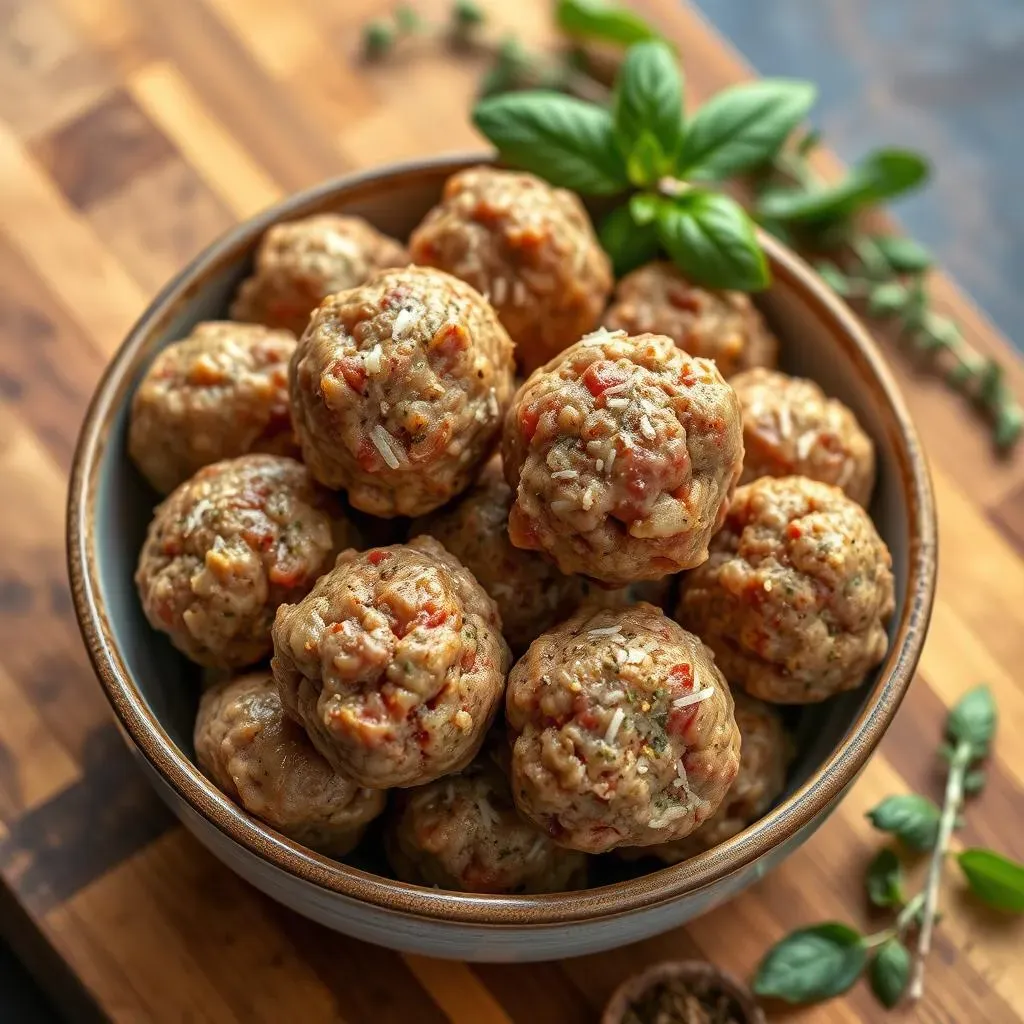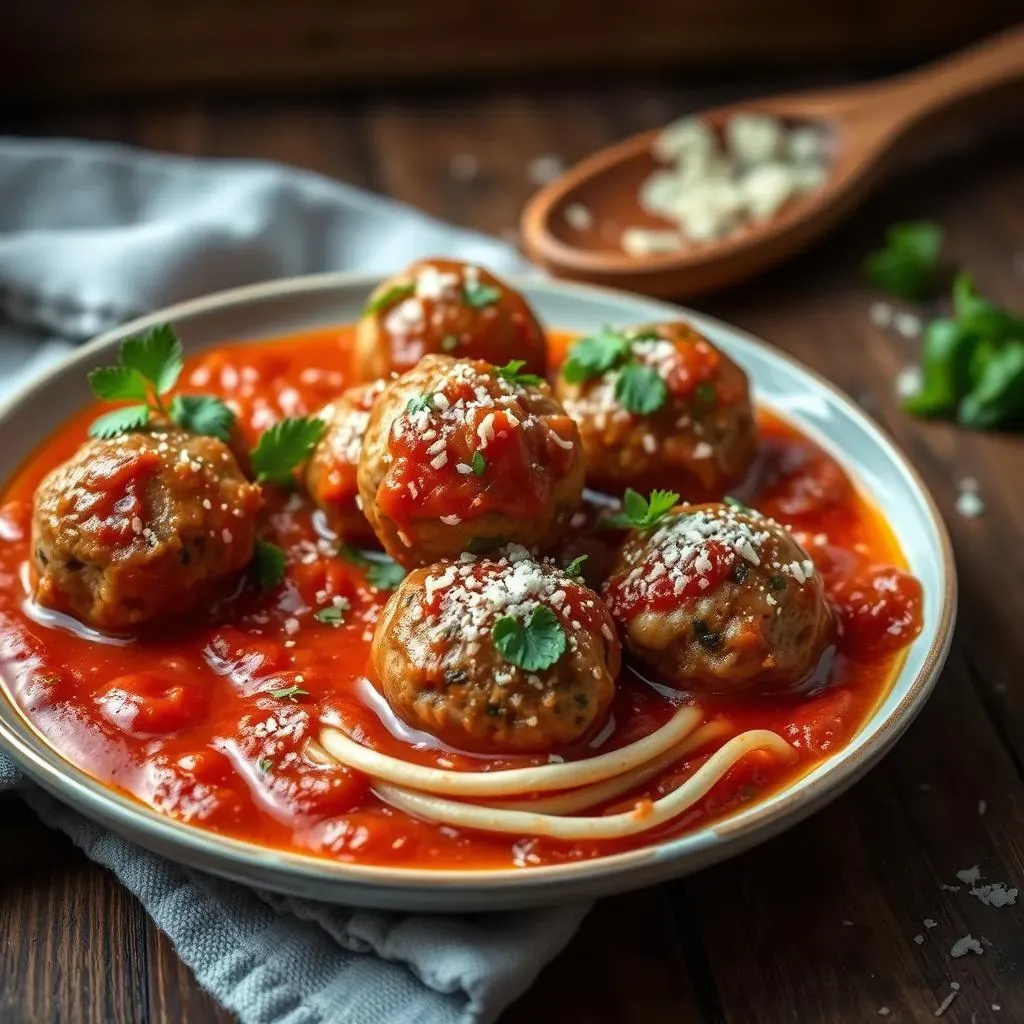Ever dream of crafting those melt-in-your-mouth Italian meatballs, the kind that make your family beg for seconds? You know, the ones that aren’t dry or tough, but juicy and bursting with flavor? I’ve been there, wrestling with recipes that promised perfection but delivered disappointment. That's why I'm excited to share my go-to italian meatball recipe 1 lb ground beef that will change your meatball game forever. We're not just throwing ingredients together; we're building a flavor bomb, step-by-step. This isn't your average meatball recipe; it's a guide to achieving consistently tender and delicious meatballs, using just one pound of ground beef. I'll walk you through why this recipe works, the key ingredients you'll need, and how to make these little spheres of happiness. We will also cover some tips, tricks, and tackle those frequently asked questions. So, get your aprons ready, and let’s make some magic happen. By the end, you'll be a meatball master, ready to impress with every single bite.
Why This Italian Meatball Recipe Works

Why This Italian Meatball Recipe Works
The Science of Tender Meatballs
Okay, so you’re probably wondering what makes these meatballs so special, right? It's all about the technique, not just luck. The secret weapon? A panade. That's a fancy way of saying a mixture of breadcrumbs and liquid (in this case, milk). This creates a super moist environment that traps all those yummy juices inside the meatball as it cooks. Without it, you risk dry, tough meatballs that are about as exciting as watching paint dry. The panade also helps the meatball stay nice and plump, preventing it from shrinking up into sad little hockey pucks. We want fluffy, flavorful goodness, not sadness!
Think of it like this: the breadcrumbs are like tiny sponges soaking up the milk, and when mixed with the beef, they release that moisture back into the meat as it cooks. It’s like a self-basting system, ensuring a juicy meatball every time.
Flavor Building Blocks
It's not just about moisture, though. Flavor is king, and this recipe doesn't skimp. We’re talking about a powerhouse combo of parmesan cheese, garlic, and Italian seasoning. These aren't just random additions; they are carefully selected to create that classic Italian taste. The parmesan adds a salty, nutty depth, while the garlic and Italian seasoning bring that aromatic warmth that makes these meatballs irresistible. It’s like a flavor symphony in every bite.
And let's not forget the importance of fresh ingredients. While dried herbs can work in a pinch, using fresh garlic elevates the flavor profile to a whole new level. It's the difference between a good meatball and a meatball that makes you want to do a happy dance.
Ingredient | Purpose |
|---|---|
Breadcrumbs & Milk | Create a panade for moisture |
Parmesan Cheese | Adds salty, nutty flavor |
Garlic & Italian Seasoning | Provide aromatic warmth |
The Cooking Method Matters
Finally, the cooking method is crucial. Many recipes skip the broiling step, but it's a game-changer. By broiling the meatballs before simmering them in the sauce, you create a beautiful crust on the outside. This not only adds texture but also prevents the meatballs from becoming soggy. The high heat of the broiler sears the surface, locking in the flavor and juices.
Then, simmering them in tomato sauce is where the magic truly happens. The acidic nature of the tomatoes helps tenderize the beef even further, creating a rich, savory flavor. It's like a slow, gentle hug that brings all the flavors together. This dual cooking method ensures that you get the best of both worlds: a crispy exterior and a tender, juicy interior.
Ingredients for the Perfect 1 lb Ground Beef Italian Meatballs

Ingredients for the Perfect 1 lb Ground Beef Italian Meatballs
Alright, so we've talked about the "why," now let's get into the "what." For this amazing italian meatball recipe 1 lb ground beef is our star, but it needs a supporting cast of equally awesome ingredients. First up, you'll need one pound of lean ground beef. I prefer lean because it gives you a good balance of flavor without being too greasy. Next, grab half a cup of breadcrumbs. Now, you can use store-bought, but I love making my own from leftover bread – it's a great way to reduce waste and it tastes better, too. Then, you'll need half a cup of milk. This is what makes the magic panade we talked about earlier. Don't go skimping on this, it's key!
Next, we need one large egg. This acts as a binder, holding all our ingredients together. You will also need a quarter cup of grated parmesan cheese. Freshly grated is always best, it has a richer flavor. Don't use the powdered stuff, it just won't do. Then, for that garlicky goodness, you'll need two cloves of garlic, minced finely. And for that classic Italian flavor, one teaspoon of Italian seasoning. Finally, a half teaspoon of salt and a quarter teaspoon of black pepper. These might seem small, but they are essential for bringing everything together.
Ingredient | Quantity | Purpose |
|---|---|---|
Lean Ground Beef | 1 lb | Main protein source |
Breadcrumbs | 1/2 cup | Creates panade for moisture |
Milk | 1/2 cup | Activates breadcrumbs in panade |
Large Egg | 1 | Acts as a binder |
Parmesan Cheese | 1/4 cup | Adds salty, nutty flavor |
Garlic, minced | 2 cloves | Provides aromatic flavor |
Italian Seasoning | 1 tsp | Adds classic Italian taste |
Salt | 1/2 tsp | Enhances flavor |
Black Pepper | 1/4 tsp | Adds a touch of spice |
Now, don't worry if you don't have every single ingredient on hand. There are some easy substitutions we can make. If you don't have fresh garlic, you can use half a teaspoon of garlic powder, but trust me, fresh is better. If you don't have Italian seasoning, you can mix together equal parts dried oregano, basil, thyme, and rosemary. And if you're out of parmesan, a similar hard cheese like romano will work. The key is to not overthink it and be willing to make small changes based on what you have.
Making Your Italian Meatballs: StepbyStep Guide

Making Your Italian Meatballs: StepbyStep Guide
Okay, let's get our hands dirty! First, you'll want to create the panade. In a large bowl, combine the breadcrumbs and milk. Let them sit for about five minutes, allowing the breadcrumbs to soak up all that lovely milk. This is super important because it's the secret to keeping your meatballs moist. While that's happening, in another bowl, gently mix the ground beef, egg, parmesan cheese, minced garlic, Italian seasoning, salt, and pepper. Don't overmix it, just bring it together. Overmixing will make your meatballs tough, and nobody wants that. Once the breadcrumbs have had their soak, add them to the meat mixture. Again, gently mix everything until just combined. You want to see all the ingredients distributed evenly, but you don't need to knead it like dough.
Now, it's time to form the meatballs. Grab a small amount of the mixture, about 2-3 tablespoons, and gently roll it between your palms to form a ball. Don't squeeze too hard, you want to keep them light and fluffy. Place each meatball on a baking sheet lined with parchment paper. This makes clean-up a breeze. Once all the meatballs are formed, pop them under the broiler for about 5-7 minutes, or until they are nicely browned on the outside. This step is crucial for texture and flavor. After broiling, transfer the meatballs into a pot of your favorite tomato sauce. Let them simmer for at least an hour, or even two, on low heat. The longer they simmer, the more tender and flavorful they become. And that's it! You've just made some incredible italian meatballs.
Step | Action | Why it Matters |
|---|---|---|
1 | Combine breadcrumbs and milk, let sit for 5 mins | Creates the panade for moisture |
2 | Mix beef, egg, cheese, garlic, seasoning, salt, pepper | Combines flavor ingredients |
3 | Add panade to meat mixture, combine gently | Brings moisture to the meat |
4 | Form meatballs, place on baking sheet | Prepares for cooking |
5 | Broil for 5-7 minutes, until browned | Creates crust, locks in flavor |
6 | Simmer in tomato sauce for 1-2 hours | Tenderizes and infuses flavor |
Tips, Tricks, and FAQs for the Best Italian Meatballs

Tips, Tricks, and FAQs for the Best Italian Meatballs
Meatball Mastery: Pro Tips for Perfection
Alright, so you've got the basics down, but let's talk about some insider secrets to really take your meatballs to the next level. First off, don't be afraid to experiment with your meat mixture. While this recipe calls for 1 lb of ground beef, you can totally mix it up. Try using half beef and half pork for a richer flavor, or even a blend of beef, pork, and veal for a truly authentic taste. Just make sure the total amount of meat is still around 1 lb so the other ingredients ratios remain correct. Also, remember that the texture of your breadcrumbs matters. If you can, use fresh breadcrumbs instead of the dry, store-bought ones. They soak up the milk better and create a more tender meatball. To make your own, just pulse a slice or two of bread in a food processor until you get the desired consistency.
Another pro tip? Don't overwork the meat mixture. The more you mix it, the tougher your meatballs will be. Gently combine all the ingredients until just mixed, and then stop. It’s like making a delicate cake – you don’t want to beat it to death. Also, before you form your meatballs, let the mixture rest in the fridge for about 15-20 minutes. This helps the flavors meld together and makes it easier to roll them into nice, even balls. It's a small step, but it makes a big difference.
Tip | Why it Works |
|---|---|
Experiment with meat blends | Adds depth of flavor |
Use fresh breadcrumbs | Creates more tender meatballs |
Don't overmix the meat | Prevents tough meatballs |
Rest meat mixture in the fridge | Helps flavors meld, easier to form |
Frequently Asked Questions: Meatball Edition
Okay, let's tackle some of those burning questions that often pop up when making meatballs. One common question is, "Can I bake these instead of broiling?" Absolutely! If you don't want to use the broiler, you can bake the meatballs in a preheated oven at 375°F (190°C) for about 20-25 minutes, or until they are cooked through. Just remember that broiling gives them that nice crust, so you might miss out on that extra texture. Another frequent question is, "Can I freeze these meatballs?" You bet! Once they've cooled down, you can freeze them in a single layer on a baking sheet. Once they're frozen solid, transfer them to a freezer bag or container. They will keep for up to three months. When you're ready to use them, just add them to your sauce while it's simmering. No need to defrost them first.
Also, people often wonder if they can make these meatballs ahead of time. The answer is yes, you can prepare the meatball mixture and form them into balls, then store them in the fridge for up to 24 hours before cooking. This makes it a great option for meal prepping or entertaining. And finally, "Can I use gluten-free breadcrumbs?" Absolutely! You can use gluten-free breadcrumbs or even almond flour as a substitute. Just keep an eye on the consistency; you may need to adjust the amount of liquid to get the right panade. Always remember, cooking is about having fun and being creative, so don't be afraid to adapt the recipe to your liking.
Troubleshooting Common Meatball Mishaps
Even with the best recipe, things can sometimes go a little sideways. So, let's talk about some common meatball problems and how to fix them. If your meatballs are turning out dry, the most likely culprit is that you didn’t use enough milk in your panade, or you overcooked them. Make sure your breadcrumbs are fully soaked and don't be afraid to add a splash more milk if the mixture seems dry. Also, keep an eye on them while they're cooking. They should be cooked through, but not overcooked. If your meatballs are falling apart, it's probably because you didn't use enough egg, or you overmixed the ingredients. Remember, the egg acts as a binder, so make sure you have the right amount. And if your meatballs are too dense, it could be because you used too much meat and not enough breadcrumbs, or you pressed them too hard when forming them. Keep it gentle. These are just a few common issues, but with a little practice, you'll be a meatball pro in no time.